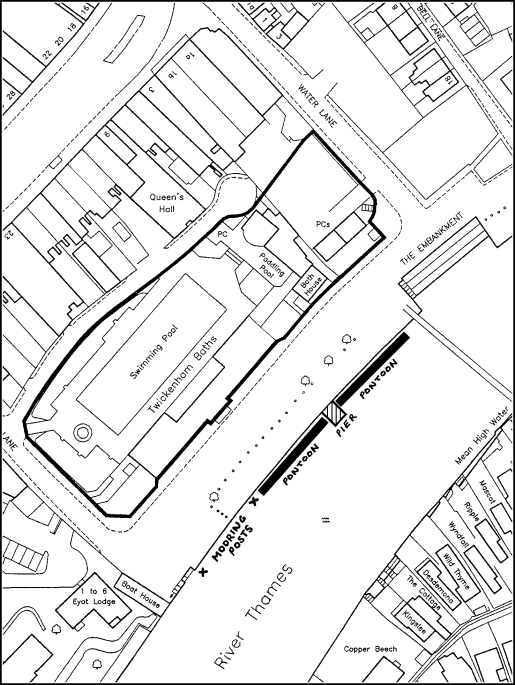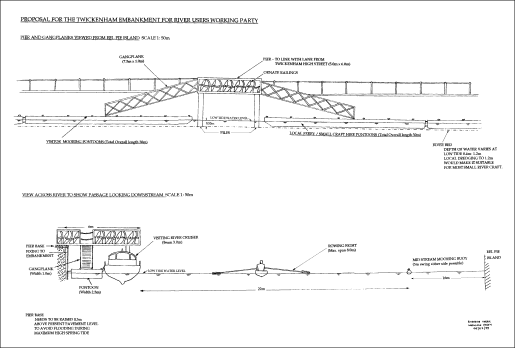| Figure 3 - Location of the Pontoon |
 |
| [Contents Page] |
The river is busy with pleasure craft in all but the worst months of the winter. It is heavily used on summer weekends and during holiday periods. If the Twickenham riverside were welcoming and offered a landing stage for small boats, visitors would come here to moor, shop, and visit.
The design brief for the riverside development stipulated a floating pontoon alongside the Twickenham Embankment. Some river and boating knowledge is necessary to specify a pontoon that will meet requirements.
We have been guided by the numerous objectives in the Unitary Development Plan, notably ENV29, ENV30, and local strategy T14 and Thames Landscape Strategy Policies (appendix 4), which relate to the conservation of boatyards, the character of different waterfronts and industrial waterfronts, and the preference for public hire of craft over private ownership, plus the need for a public landing place.
Twickenham's distinctive river scene should be enhanced, and while pontoons are usually functional structures they can also be aesthetically pleasing. A well-designed pier or observation platform could be an attractive architectural feature to enhance the Embankment.
We propose that two floating pontoons, separated by a small pier, could be built close to and upstream of the Eel Pie Island bridge. One would take visitors' craft and the other would be for boats for public hire. Two mooring piles could also be installed for the use of larger craft, like narrowboats.
In researching this section of the report, two possible locations for a pontoon were considered, one at the upstream end of the site alongside the pool, and a second downstream, at the double watermen’s steps by the Barmy Arms. These are the only places that offer sufficient depth of water under most tidal conditions, without incurring a need for dredging. Though the downstream location does offer a wider channel, any navigation by sizeable boats must take into consideration the height and prominence of the Eel Pie Island bridge, plus the variations in water level according to the state of the tide.
There was considerable debate about the factors governing a pontoon:
Taking all these into account we suggest that the most feasible location for a pontoon is at the upstream end of the site.
At the upstream end would be two floating pontoons for visitor mooring, of a total length of 30 metres, 2.5 metres wide. They would slide on vertical rails attached to the Embankment wall, and they would be reached by a gangplank, 7.5 metres long, 1 metre wide.
The top of the gangplank would be attached to a pier which links to the Embankment. The pier is 5 metres wide and 6 metres deep. The ideal position for it is facing the centre of the pool site and the Eel Pie Centre. There is an opportunity here for custom-made ironwork by local sculptors.
Downstream of the pier would be the second set of pontoons for local ferries and small craft hire. The total length would be 30 metres and they would also be accessed by a gangplank.
The total width of the structure would be approximately 6 metres, and the length 65 metres. There would be no need for facilities on the visitors' moorings as they would only be intended for short stay. The hire pontoon will require an electric point for charging batteries for electric craft, and perhaps also a water tap. Storage and small office space could be in the Eel Pie Centre. The current cost for fully equipped pontoons of this type is estimated to be £600 per metre.
In addition, two mooring piles would be installed further upstream from the pontoons. They could moor a 25 metre barge or the like, capable of taking the ground. If they were made of greenheart, these would cost £2000 apiece, installed.
| Figure 4 - The Pontoon |
| (Click on the drawing to download an enlarged version - 36kB) |
 |
The pontoon would seem to offer almost infinite possibilities to enrich the river and commercial life of Twickenham.
a. The pontoon will provide an outlet for boating businesses on the island by providing a place for hiring small rowing boats, canoes, or electric launches. b. Small and medium-sized tour boats could call here to pick up and drop off passengers, and bring in tourist revenue. Local people would gain a boat service from Twickenham into, say, Richmond and Kingston. c. The pontoon could be used by the local ferries that were run on an experimental basis during Twickenham Week, around the island to the Surrey side and upriver to Teddington and down to Richmond. d. There is a continual passing trade of holiday makers and people out on boats for the weekend, who are looking for nice places to stop. The pontoon would provide leisure moorings that will benefit the local economy by bringing boat owners into the town centre. The busyness of the short-term moorings at Kingston indicates that there is a need for this kind of space, and people who come to look around an attractive riverside will also go into Church Street and the town centre to shop. This will draw people into the town centre without putting additional strain on traffic or parking. e. They could be the base for river-related courses for RYA and BCU qualifications, and for other training programmes connected to the boatyards and local colleges and clubs. f. The marionette theatre could moor here, and it could be the centre for river events during Twickenham Week, and for rallies for groups like the Electric Boat Association and the Inland Waterways Association. g. Boats coming from the Grand Union Canal at Brentford need places to moor overnight, prior to passing through Teddington Lock. Again, boat owners will shop and go to restaurants and pubs if there is hospitable mooring space.
a. The pontoons will require management, in the interests of the town and of boat users. There will be mooring fees to be collected from visiting craft, and it may be necessary to have someone on hand to ensure that the facilities are properly used. b. Channel width: the channel is relatively narrow, and the island side is lined with permanent moorings. The width varies, depending on the tide and the weather and how boats swing on mornings, and it is narrowest at low water. From observation and measurements taken from Port of London Authority surveys, there is not less than a 25 metre width (or 22 metres, allowing for the width of the pontoon) which is sufficient. We do not envisage any difficulties in operation that cannot be overcome. c. In the early mornings, late afternoons and at weekends, the channel is busy with skiffs from the rowing club. A rowing eight is 20 metres long with an oar span of 7.6 metres. With an experienced cox on a fine day, a channel width of 9 metres is sufficient. However, with an inexperienced cox, a strong tide or gusty wind, a skiff can need an additional 2 to 2.5 metres of channel. d. There is some concern that the pontoons could be used at night by the big disco steamers, though the companies which run them have shown little interest in docking in Twickenham because of the problems with the depth of water, the difficulty of manoeuvring in the narrow channel, and the height of the Eel Pie Island bridge. e. Any change of existing practice will require regulatory approval of the Port of London Authority and the Environment Agency, and a licence from the PLA will be required for any piles and pontoons. f. The needs of the disabled will have to be addressed.
a. Pontoons will need regulation, maintenance, and policing, to deter theft, vandalism, and long-term mooring. b. Increased traffic will affect the rowing club and the yacht club: sharing the river increases the strain on the resource. c. There is an possible risk to public safety, especially for the disabled: the pontoons must meet established safety regulation. d. Effective river management will be required to prevent incidents due to the increased river traffic. It might be necessary for the one way upstream regulation for the channel to be encouraged, possibly with signposting. e. There is a possible threat to wildlife in the nature sanctuaries at both ends of Eel Pie Island. (See appendix 5 for the letter from John Hatto, London Wildlife Trust.)
| [Contents Page] |